
Author: Rana R. Said, MD, FAAN
University of Texas Southwestern Medical Center, Children’s Health Dallas
Reviewed: November 2021
SUMMARY
Ring chromosome 14 syndrome, or r(14), is a rare genetic disorder. Only about 80 cases have been described since it was first reported in 1971.
R(14) is characterized by:
- Early onset refractory epilepsy, a seizure disorder that can be hard to control
- Intellectual disability
- Autism spectrum disorder
- Characteristic facial features
- Other health issues, including feeding difficulties
JUMP TO
Disorder Overview
DESCRIPTION
R(14) is a lifelong genetic disorder. Human genetic material is made up of 23 pairs of chromosomes. Usually, these chromosomes are in a straight stick shape. However, sometimes the 14th pair of these chromosomes has a ring-like appearance instead. This is because of small, abnormal deletions and connections that can happen within that chromosome.
These differences to the 14th chromosome can cause r(14).
R(14) itself is very rare. However, its features are not unique to r(14). Other disorders commonly cause some of the same symptoms. Further, r(14) does not look only one way. Its features can vary. It is therefore very hard to tell if a child has r(14) or another disorder. Genetic testing is the only way to be sure.
SIGNS AND SYMPTOMS
R(14) can result in a number of different symptoms. These symptoms are common in many other disorders as well.
Symptoms include:
Intellectual disability
Epilepsy
All people with r(14) have epilepsy, which causes seizures. Most of the time, people with r(14) have a type of epilepsy called early onset refractory epilepsy. In this type of epilepsy, seizures are hard to control. Seizures that begin earlier and are more severe may result in more disability. They can also increase the probability of autism spectrum disorder.
Seizures in r(14):
- Usually appear in the first few months of life
- Are focal, with or without secondary generalization
- Usually occur when waking up or falling asleep
- Sometimes occur in clusters that last a day or more
- Include long “status epilepticus” seizures lasting more than 5 minutes in about half of patients
- Are usually worse when younger and often get better by late adolescence
- Can cause a loss of other skills
Trouble walking
Infection
Autism spectrum disorder (ASD)
Many children with r(14) have traits of ASD, such as:
- Aimless or repetitive motor movements
- Need for routine
- Sensory sensitivities, like a sensitivity to texture or noise
Characteristic facial features
Low muscle tone
Also called hypotonia.
Small head size
Also called microcephaly.

CAUSES
R(14) is a genetic disorder. It is caused by a genetic difference in the r(14) chromosome. This difference is usually de novo, meaning that it appears by chance. Only in very rare cases can r(14) be inherited.
R(14) is not caused by anything the mother did or did not do during pregnancy.
LAB INVESTIGATIONS
R(14) can only be diagnosed through genetic testing. The main type of genetic test used is called a karyotype test. A karyotype test can look to see if there is a ring on the 14th chromosome.
Other tests usually given to children with r(14) include:
- Eye exams.
- Electroencephalogram (EEG). EEGs can measure the electrical activity of the brain. They can be helpful in detecting seizures. EEGs may be repeated periodically.
- Neuropsychological evaluations.

TREATMENT AND THERAPIES
Treatment may vary based on the severity of the disorder. R(14) is a lifelong condition with no specific cure. Therefore, treatments are focused on improving symptoms.
Team Approach
Using multidisciplinary treatment teams is the best approach to treating r(14). A treatment team is made up of a number of different specialists. Treatment teams for r(14) may include:
- Pediatricians
- Child neurologists
- Gastroenterologists
- Nutritionists
- Rehabilitation physicians
- Pulmonologists, or lung doctors
- Ophthalmologists, or eye doctors
- Therapists who specialize in speech, physical, and occupational therapies
Treating Symptoms
A few symptoms of r(14) that can be treated include:
Epilepsy
Low muscle tone
Vision and hearing issues
Malnutrition
Children with r(14) are at a high risk for malnutrition. They need close attention from nutritionists. A nutritionists can monitor weight closely and add supplements to the diet when needed. Speech therapists can also help. They can ensure the child can swallow safely. A gastrostomy tube may eventually be needed.
Communication and speech challenges

Family and Caregiver Support
Taking care of a child with a rare and complex syndrome is challenging. R(14) can have impact not only on a child but also parents and siblings. Families might need strong support. This can include:
- Attention and time given to unaffected sibling
- Peer support groups for those whose lives are affected by r(14)
OUTLOOK
R(14) is a lifelong condition with no cure. Children with the disorder will not be able to function independently as adults. They will typically need assistance with all activities of daily living. Long-term intensive therapies are very important. They can make sure that children with r(14) can function to their full potential.
Caring for a child with a rare disorder and complex medical needs can be stressful for families. In particular, a spouse staying home as a caregiver and unaffected siblings may feel added stress. It is important that the entire family get the support they need.
RELATED DISORDERS
R(14) shares some features with another syndrome called 14q32q33 deletion syndrome. However, the 14q32q33 deletion syndrome is usually less severe than r(14).
Resources
Ring14 USA
Ring14 USA is a non-profit organization founded by a group of mothers whose children have Ring14 syndrome. They advocate for all those affected by the rare neurodevelopmental disorders of the 14th chromosome, in particular Ring14 syndrome. From the children who suffer from the symptoms to all the doctors, caregivers, friends, and family who help to care for these fragile children. Ring14’s vision is to create a brighter future for these children by finding targeted treatments and therapies which will enable them to reach their full potential and live their best life. They have created a supportive community for the Ring14 families, so that no one faces these challenges alone. Ring14 USA hosts the Ring14 USA private Facebook group which has over 100 members.
Research efforts are organized through Ring14 International, a worldwide nonprofit organization that functions as a coordinating network for the various national Ring14 chapters which all share the same objectives. The main goals of Ring14 International is to support and promote, on an international level, medical and scientific research regarding the syndromes of the 14th chromosome. Ring14 International consists of the established chapters in Italy and USA and new chapters in France, Spain, Netherlands, and Belgium with more opening in the future. Ring14 International hosts the Chromosome Ring 14 International private Facebook group with over 400 members.

Child Neurology Foundation (CNF) solicits resources from the community to be included on this webpage through an application process. CNF reserves the right to remove entities at any time if information is deemed inappropriate or inconsistent with the mission, vision, and values of CNF.
Research
Currently, there are no listings for Chromosome 14 Ring/Ring 14/Ring Chromosome 14 in ClinicalTrials.gov. Check back often and talk with your healthcare provider to identify upcoming trials.
If you have an interest in searching for any future trials that may be starting:
- Go to the Home page of ClinicalTrials.gov
- Under “Status”, click on “Recruiting and not yet recruiting studies”
- Under “Condition or disease”, type Chromosome 14 Ring, Ring 14 or Ring Chromosome 14 in the field. A drop-down list will appear if this disorder is included.
- You can narrow the search by entering a Country name
- Once on the disorder page of trials, narrow your search under “Eligibility Criteria” and click “Age/Age Group/Child (birth to 17)”
The information in the CNF Child Neurology Disorder Directory is not intended to provide diagnosis, treatment, or medical advice and should not be considered a substitute for advice from a healthcare professional. Content provided is for informational purposes only. CNF is not responsible for actions taken based on the information included on this webpage. Please consult with a physician or other healthcare professional regarding any medical or health related diagnosis or treatment options.
References
Ring 14 International Onlus. https://www.ring14.org
Rinaldi B, Vaisfeld A, Amarri S, Baldo C, Gobbi G, Magini P, Melli E, Neri G, Novara F, Pippucci T, Rizzi R, Soresina A, Zampini L, Zuffardi O, and Crimi M. Guideline recommendations for diagnosis and clinical management of Ring14 syndrome – First report of an ad hoc task force. Orphanet J Rare Dis. 2017;12:69. https://doi.org/10.1186/s13023-017-0606-4
Pezzolo A, Gimelli G, Cohen A, Lavaggetto A, Romano C, Fogu G, Zuffardi O. Presence of telomeric and subtelomeric sequences at the fusion points of ring chromosomes indicates that the ring chromosome is caused by ring instability. Hum Genet. 1993;92:23–7. PMID: 8365723. https://doi.org/10.1007/bf00216140
Guilherme RS, Meloni VF, Kim CA, Pellegrino R, Takeno SS, Spinner NB, Conlin LK, Christofolini DM, Kulikowski LD, Melaragno MI. Mechanisms of ring chromosome formation, ring instability and clinical consequences. BMC Med Genet. 2011;12:171. PMID: 22188645. https://doi.org/10.1186/1471-2350-12-171
Kamnasaran D, Cox DW. Current status of human chromosome 14. J Med Genet. 2002;39:81–90. PMID: 11836355. https://doi.org/10.1136/jmg.39.2.81
Zollino M, Seminara L, Orteschi D, Gobbi G, Giovannini S, Della Giustina E, Frattini D, Scarano A, Neri G. The ring 14 syndrome: Clinical and molecular definition. Am J Med Genet A. 2009;149:1116–24. https://doi.org/10.1002/ajmg.a.32831
Zampini L, D’Odorico L, Zanchi P, Zollino M, Neri G. Linguistic and psychomotor development in children with chromosome 14 deletions. Clin Linguist Phon. 2012;26:962–73. PMID: 23057796. https://doi.org/10.3109/02699206.2012.728669
Giovannini S, Frattini D, Scarano A, Fusco C, Bertani G, Della Giustina E, Martinelli P, Orteschi D, Zollino M, Neri G, Gobbi G. Partial epilepsy complicated by convulsive and nonconvulsive episodes of status epilepticus in a patient with ring chromosome 14 syndrome. Epileptic Disord. 2010;12:222–7. PMID: 20643614. https://doi.org/10.1684/epd.2010.0324
[testimonial_view id=”4″]
